
Lithuanian National Drama Theatre, located on Gediminas Avenue in Vilnius, is one of Lithuania’s most prominent publicly funded performing arts venues and cultural institutions. Founded as a Vilnius State Theatre in 1940, it became Lithuanian National Drama Theatre in 1998. The theatre’s façade featuring the Feast of Muses sculpture by Stanislovas Kuzma has become a landmark of Vilnius city.
The Act of Mielnik or Union of Mielnik was an attempt to unite the Kingdom of Poland with the Grand Duchy of Lithuania in 1501. It was not ratified by the Lithuanian Seimas or by the Polish Sejm. The Act of Mielnik remained just a political project. Despite the failure to unify two countries into a single state, Poland and Lithuania were under a personal union until the Union of Lublin of 1569.
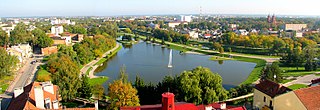
Panevėžys is the fifth largest city in Lithuania. As of 2011, it occupied 52 square kilometres (20 sq mi) with 113,653 inhabitants. As defined by Eurostat, the population of Panevėžys functional urban area, that stretches beyond the city limits, is estimated at 127,471

The Cathedral Basilica of St Stanislaus and St Ladislaus of Vilnius is the main Catholic cathedral in Lithuania. It is situated in Vilnius Old Town, just off Cathedral Square. Dedicated to the Christian saints Stanislaus and Ladislaus, the church is the heart of Catholic spiritual life in Lithuania.

Venta is a small city in Lithuania in the Akmenė district municipality. According to a 2021 census, there are 2,250 people living in Venta. It is situated along the Venta River, Kuršėnai-Mažeikiai highway, and a railroad connecting Mažeikiai with Šiauliai. This makes Venta better situated than Naujoji Akmenė, the capital of the district. Venta is also one kilometre (0.62 mi) from the small villages of Žerkščiai and Pašilė (Akmenė). There is a small bridge connecting Venta to Žerkščiai. There are 2 Seniūnaitijas which make up Venta; "Draugystės" and "Ventos Miesto".

Three Crosses is a prominent monument in Vilnius, Lithuania, on the Hill of Three Crosses, originally known as the Bald Hill, in Kalnai Park. According to a legend, which finds its source in some historic events, seven Franciscan friars were beheaded on top of this hill. Wooden crosses have been sited in the location since the early 17th century, and they became a symbol of the city and an integral part of the city's skyline.
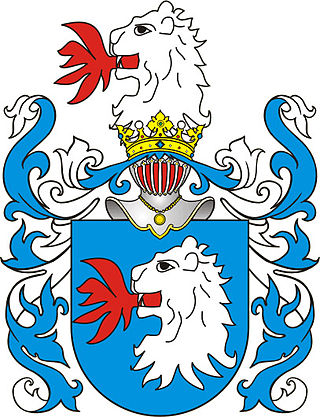
Stanislovas Kęsgaila Jonaitis was a Lithuanian nobleman, son of Jonas Kęsgaila from the Kęsgailos family. Stanislovas Kęsgaila was the Elder of Samogitia (1486–1522), Grand Hetman of Lithuania (1501–1502), castellan of Trakai (1499–1522) and Vilnius (1522–1526).
Edvardas Gudavičius was a Lithuanian historian. He was known as one of the best historians in Lithuania specializing in the early history of Grand Duchy of Lithuania and is an author of many publications.

The first known record of the name of Lithuania is in a 9 March 1012 story of Saint Bruno recorded in the Quedlinburg Chronicle. The Chronicle recorded a Latinized form of the Old Church Slavonic word for Lithuania—Литва—Latinized as Litva. Although it is clear the name originated from a Baltic language, scholars still debate the meaning of the word.
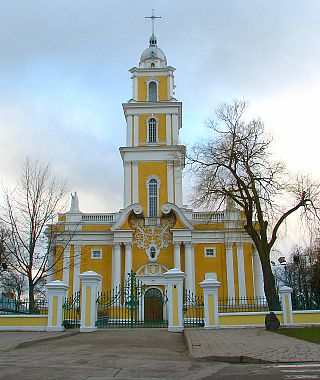
The Roman Catholic Diocese of Panevėžys is a diocese located in the city of Panevėžys in the Ecclesiastical province of Vilnius in Lithuania. It was established on April 4, 1926 from the Diocese of Samogitia. The Christ the King Cathedral is the Bishop's Cathedral of the diocese since the declaration of Pope Pius XI in 1926.
Bronius Vyšniauskas was a Lithuanian sculptor. He was an Honored Art Worker of the Lithuanian Soviet Socialist Republic (1963), People's Artist of the Lithuanian SSR (1973), and a recipient of the Lithuanian SSR State Prize (1973).
Vidmantas Jažauskas is a Lithuanian painter, book illustrator, poet, and social activist.
Juozas Lebednykas is a Lithuanian artist and sculptor.

The Freedom Monument in Kaunas, Lithuania by sculptor Juozas Zikaras was unveiled in 1928 on the occasion of the 10th anniversary of the reestablishment of the independence of Lithuania. At that time Kaunas was the temporary capital of the state. The statue of the monument is also pictured on the obverse of the Independence Medal, also designed by Zikaras and issued in 1928.
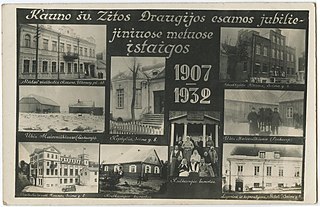
The Society of Saint Zita was a Lithuanian Catholic professional society of female servants and other workers active from 1905 to 1940. It was one of the first organizations of Lithuanian women. Its members were known as zitietės.
The siege of Smolensk was an unsuccessful attempt to capture Smolensk by the forces of the Grand Duchy of Moscow in summer 1502. It was the last major military engagement during the Muscovite–Lithuanian War (1500–1503).
The 2019 A Lyga was the 30th season of the A Lyga, the top-tier association football league of Lithuania. The season began on 2 March 2019 and ended on 27 November 2019.
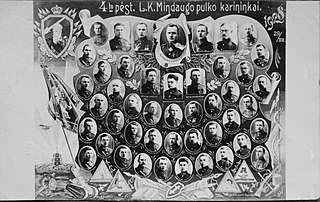
4th Infantry Regiment, later the 4th Infantry Regiment of the Lithuanian King Mindaugas was a Lithuanian Army infantry regiment that existed from 1918 to 1940 and was located in Panevėžys.

Antanas Stapulionis was a Lithuanian lieutenant colonel and chief of the Panevėžys Staff of the June Uprising in Lithuania.

















